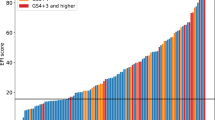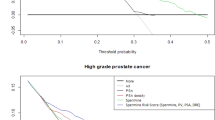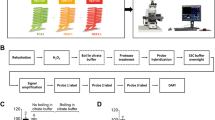Abstract
Background:
New screening methods that can add predictive diagnostic value for aggressive (high-grade, Gleason score ⩾7) prostate cancer (PCa) are needed to reduce unnecessary biopsies for patients with non-aggressive PCa. This is particularly important for men presenting for an initial biopsy with an equivocal PSA in the 2–10 ng ml−1 range. PCA3 and ERG are biomarkers that can add predictive value for PCa in urine; however, with a limited utility as a digital rectal exam (DRE) is required.
Methods:
First-catch urine samples were collected at six sites from men scheduled to undergo a prostate biopsy. Exosomal RNA was extracted, RNA copy numbers of ERG and PCA3 were measured by reverse transcription–quantitative PCR (RT–qPCR), and the EXO106 score (the sum of normalized PCA3 and ERG RNA levels) was computed. Performance was compared with standard of care (SOC; PSA, age, race or family history) parameters. Contingency table, logistic regression, receiver operating characteristics curve and box-plot analyses were performed.
Results:
In this cohort (N=195), a dichotomous EXO106 score demonstrated good clinical performance in predicting biopsy result for both any cancer and high-grade disease. For high-grade disease, the negative and positive predictive values were 97.5% and 34.5%, respectively. The discrimination between high-grade and Gleason score ⩽6 (including benign) biopsy results by a combination of EXO106 and SOC (area under the curve (AUC)=0.803) was significantly improved compared with SOC without EXO106 (AUC=0.6723, P=0.0009). The median EXO106 score correlated (P<0.001; Spearman’s rank order) with histologic grade.
Conclusions:
A novel molecular signature (EXO106 score) derived from non-DRE urine demonstrated independent, negative predictive value for the diagnosis of high-grade PCa from initial biopsy for men with ‘gray zone’ serum PSA levels. Its use in the biopsy decision process could result in fewer prostate biopsies for clinically insignificant disease.
This is a preview of subscription content, access via your institution
Access options
Subscribe to this journal
Receive 4 print issues and online access
$259.00 per year
only $64.75 per issue
Buy this article
- Purchase on Springer Link
- Instant access to full article PDF
Prices may be subject to local taxes which are calculated during checkout


Similar content being viewed by others
References
Siegel R, Ma J, Zou Z, Jemal A . Cancer statistics, 2014. CA J Clin 2014; 64: 9–29.
Bjurlin MA, Wysock JS, Taneja SS . Optimization of prostate biopsy: review of technique and complications. Urol Clin North Am 2014; 41: 299–313.
Lundstrom KJ, Drevin L, Carlsson S, Garmo H, Loeb S, Stattin P et al. Nationwide population based study of infections after transrectal ultrasound guided prostate biopsy. J Urol 2014; 192: 1116–1122.
Nam RK, Saskin R, Lee Y, Liu Y, Law C, Klotz LH et al. Increasing hospital admission rates for urological complications after transrectal ultrasound guided prostate biopsy. J Urol 2010; 183: 963–968.
Bruyere F, Malavaud S, Bertrand P, Decock A, Cariou G, Doublet JD et al. Prosbiotate: a multicenter, prospective analysis of infectious complications after prostate biopsy. J Urol 2014; 193: 145–150.
Abouassaly R, Thompson IM Jr, Platz EA, Klein EA Epidemiology, etiology, and prevention of prostate cancer. In: McDougal WS, Wein A, Kavoussi L, Novick AC, Partin AW, Peters CA et al (eds). Campbell-Walsh Urology, 10th edn. Elsevier Saunders: Philadelphia, PA, USA, 2012.
Berman DM, Epstein JI . When is prostate cancer really cancer? Urol Clin North Am 2014; 41: 339–346.
Klotz L . Active surveillance versus radical treatment for favorable-risk localized prostate cancer. Curr Treat Opt Oncol 2006; 7: 355–362.
Getzenberg RH, Partin AW. Prostate cancer tumor markers. In: Wein AJ, Kavoussi LR, Novick AC, Partin AW, Peters CA (eds). Campbell-Walsh Urology, 10th edn. Elsevier Saunders: Philadelphia, PA, USA, 2012.
Loeb S, Vellekoop A, Ahmed HU, Catto J, Emberton M, Nam R et al. Systematic review of complications of prostate biopsy. Eur Urol 2013; 64: 876–892.
Schroder FH, Hugosson J, Roobol MJ, Tammela TL, Zappa M, Nelen V et al. Screening and prostate cancer mortality: results of the european randomised study of screening for prostate cancer (ERSPC) at 13 years of follow-up. Lancet 2014; 384: 2027–2035.
Bill-Axelson A, Holmberg L, Garmo H, Rider JR, Taari K, Busch C et al. Radical prostatectomy or watchful waiting in early prostate cancer. N Engl J Med 2014; 370: 932–942.
Wilt TJ, Brawer MK, Jones KM, Barry MJ, Aronson WJ, Fox S et al. Radical prostatectomy versus observation for localized prostate cancer. N Engl J Med 2012; 367: 203–213.
van der Vos KE, Balaj L, Skog J, Breakefield XO . Brain tumor microvesicles: insights into intercellular communication in the nervous system. Cell Mol Neurobiol 2011; 31: 949–959.
Nilsson J, Skog J, Nordstrand A, Baranov V, Mincheva-Nilsson L, Breakefield XO et al. Prostate cancer-derived urine exosomes: a novel approach to biomarkers for prostate cancer. Br J Cancer 2009; 100: 1603–1607.
Skog J, Wurdinger T, van Rijn S, Meijer DH, Gainche L, Sena-Esteves M et al. Glioblastoma microvesicles transport RNA and proteins that promote tumour growth and provide diagnostic biomarkers. Nat Cell Biol 2008; 10: 1470–1476.
Valadi H, Ekstrom K, Bossios A, Sjostrand M, Lee JJ, Lotvall JO . Exosome-mediated transfer of mRNAs and microRNAs is a novel mechanism of genetic exchange between cells. Nat Cell Biol 2007; 9: 654–659.
Miranda KC, Bond DT, McKee M, Skog J, Paunescu TG, Da Silva N et al. Nucleic acids within urinary exosomes/microvesicles are potential biomarkers for renal disease. Kidney Int 2010; 78: 191–199.
Miranda KC, Bond DT, Levin JZ, Adiconis X, Sivachenko A, Russ C . Massively parallel sequencing of human urinary exosome/microvesicle RNA reveals a predominance of non-coding RNA. PLoS One 2014; 9: e96094.
Thompson IM, Ankerst DP, Chi C, Goodman PJ, Tangen CM, Lucia MS et al. Assessing prostate cancer risk: results from the Prostate Cancer Prevention Trial. J Nati Cancer Inst 2006; 98: 529–534.
Thompson IM, Pauler DK, Goodman PJ, Tangen CM, Lucia MS, Parnes HL et al. Prevalence of prostate cancer among men with a prostate-specific antigen level < or =4.0 ng per milliliter. N Engl J Med 2004; 350: 2239–2246.
Hessels D, Klein Gunnewiek JM, van Oort I, Karthaus HF, van Leenders GJ, van Balken B et al. DD3(PCA3)-based molecular urine analysis for the diagnosis of prostate cancer. Eur Urol 2003; 44: 8–15; discussion -6.
St John J, Powell K, Conley-Lacomb MK, Chinni SR . TMPRSS2-ERG fusion gene expression in prostate tumor cells and its clinical and biological significance in prostate cancer progression. J Cancer Sci Ther 2012; 4: 94–101.
Gittelman MC, Hertzman B, Bailen J, Williams T, Koziol I, Henderson RJ et al. PCA3 molecular urine test as a predictor of repeat prostate biopsy outcome in men with previous negative biopsies: a prospective multicenter clinical study. J Urol 2013; 190: 64–69.
Laxman B, Morris DS, Yu J, Siddiqui J, Cao J, Mehra R et al. A first-generation multiplex biomarker analysis of urine for the early detection of prostate cancer. Cancer Res 2008; 68: 645–649.
Laxman B, Tomlins SA, Mehra R, Morris DS, Wang L, Helgeson BE et al. Noninvasive detection of TMPRSS2:ERG fusion transcripts in the urine of men with prostate cancer. Neoplasia 2006; 8: 885–888.
Leyten GH, Hessels D, Jannink SA, Smit FP, de Jong H, Cornel EB et al. Prospective multicentre evaluation of PCA3 and TMPRSS2-ERG gene fusions as diagnostic and prognostic urinary biomarkers for prostate cancer. Eur Urol 2014; 65: 534–542.
Rice KR, Chen Y, Ali A, Whitman EJ, Blase A, Ibrahim M et al. Evaluation of the ETS-related gene mRNA in urine for the detection of prostate cancer. Clin Cancer Res 2010; 16: 1572–1576.
Salami SS, Schmidt F, Laxman B, Regan MM, Rickman DS, Scherr D et al. Combining urinary detection of TMPRSS2:ERG and PCA3 with serum PSA to predict diagnosis of prostate cancer. Urol Oncol 2013; 31: 566–571.
Dijkstra WS, Birker IL, Smit FP, Leyten GH, de Reijke TM, van Oort IM et al. Prostate cancer biomarker profiles in urinary sediments and exosomes. J Urol 2014; 191: 1132–1138.
Cheng XH, Black M, Ustiyan V, Le T, Fulford L, Sridharan A et al. SPDEF inhibits prostate carcinogenesis by disrupting a positive feedback loop in regulation of the Foxm1 oncogene. PLoS Genet 2014; 10: e1004656.
Haller AC, Tan W, Payne-Ondracek R, Underwood W, Tian L, Morrison C et al. High SPDEF may identify patients who will have a prolonged response to androgen deprivation therapy. Prostate 2014; 74: 509–519.
Oettgen P, Finger E, Sun Z, Akbarali Y, Thamrongsak U, Boltax J et al. PDEF, a novel prostate epithelium-specific ets transcription factor, interacts with the androgen receptor and activates prostate-specific antigen gene expression. J Biol Chem 2000; 275: 1216–1225.
Hagen RM, Adamo P, Karamat S, Oxley J, Aning JJ, Gillatt D et al. Quantitative analysis of ERG expression and its splice isoforms in formalin-fixed, paraffin-embedded prostate cancer samples: association with seminal vesicle invasion and biochemical recurrence. Am J Clin Pathol 2014; 142: 533–540.
Svensson MA, Perner S, Ohlson AL, Day JR, Groskopf J, Kirsten R et al. A comparative study of ERG status assessment on DNA, mRNA, and protein levels using unique samples from a Swedish biopsy cohort. Appl Immunohistochem Mol Morphol 2014; 22: 136–141.
He J, Schepmoes AA, Shi T, Wu C, Fillmore TL, Gao Y et al. Analytical platform evaluation for quantification of ERG in prostate cancer using proteins and mRNA detection methods. J Transl Med 2015; 54: 1–14.
Hansen J, Rink M, Bianchi M, Kluth LA, Tian Z, Ahyai SA et al. External validation of the updated Briganti nomogram to predict lymph node invasion in prostate cancer patients undergoing extended lymph node dissection. Prostate 2013; 73: 211–218.
Acknowledgements
Technical and scientific writing was done by Dr Julie Deardorff, Pacifica Scientific Consulting.
Author information
Authors and Affiliations
Corresponding author
Ethics declarations
Competing interests
MN, SB, SB, JS and VO'N are employees of Exosome Diagnostics; MJD is a consultant to Exosome Diagnostics. The remaining authors declare no conflict of interest
Additional information
Supplementary Information accompanies the paper on the Prostate Cancer and Prostatic Diseases website
Supplementary information
Rights and permissions
About this article
Cite this article
Donovan, M., Noerholm, M., Bentink, S. et al. A molecular signature of PCA3 and ERG exosomal RNA from non-DRE urine is predictive of initial prostate biopsy result. Prostate Cancer Prostatic Dis 18, 370–375 (2015). https://doi.org/10.1038/pcan.2015.40
Received:
Revised:
Accepted:
Published:
Issue Date:
DOI: https://doi.org/10.1038/pcan.2015.40
This article is cited by
-
Urinary marker panels for aggressive prostate cancer detection
Scientific Reports (2022)
-
Predicting high-grade prostate cancer at initial biopsy: clinical performance of the ExoDx (EPI) Prostate Intelliscore test in three independent prospective studies
Prostate Cancer and Prostatic Diseases (2022)
-
Validation of a CE-IVD, urine exosomal RNA expression assay for risk assessment of prostate cancer prior to biopsy
Scientific Reports (2022)
-
Prostate cancer and the role of biomarkers
Abdominal Radiology (2020)
-
How should radiologists incorporate non-imaging prostate cancer biomarkers into daily practice?
Abdominal Radiology (2020)



